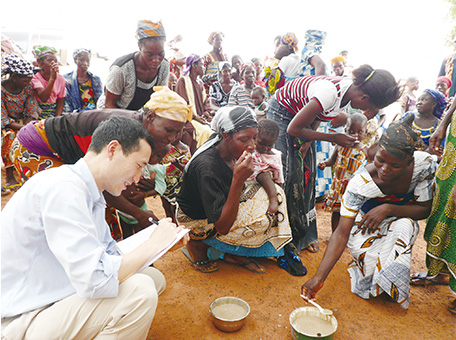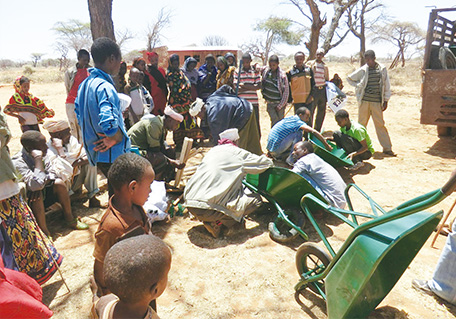Japan's Official Development Assistance White Paper 2013
(3) Food and Nutrition
According to the joint report from the Food and Agriculture Organization of the UN (FAO), the International Fund for Agricultural Development (IFAD) and the World Food Programme (WFP), the number of undernourished people has shown a downward trend since 1990, but the trend has slowed since 2007-2008 and an estimated 842 million people were suffering from chronic undernourishment between 2011 and 2013. That number is still high, and the need for food aid is increasing due to conflict, natural disasters and rising food prices. In addition, there is a need for international coordination and multifaceted measures to establish food security (guaranteeing the right of all people to sufficient food), such as ensuring social safety-net, improving nutrition, improving the balance of supply and demand thorough increasing food production, and measures against infectious diseases of livestock.
According to the joint report from FAO, IFAD and WFP, we are on track to achieve the MDG 1 of halving the percentage of the population suffering from starvation from the 1990 level by 2015 (23.2% to 11.6%) and the target will be achievable if the abovementioned actions continue to be taken thoroughly and appropriately (the level is 14.3% as of 2013).
Furthermore, since it is especially effective to improve nutrition during the first 1,000 days from a mother’s pregnancy to her child’s 2nd birthday, efforts to improve nutrition during this period are promoted.
<Japan’s Efforts>
In light of these circumstances, Japan provides food assistance based on requests from developing countries confronting food shortages. In FY2012, Japan provided a total of ¥5.65 billion in bilateral food assistance projects to 12 countries.
In addition to that, Japan provides through WFP, emergency food assistance, support for school feeding programs to increase school enrollment and regular attendance, support for promotion of participation in work for development of agricultural land and social infrastructure to support the self-reliance of local communities. In 2012, Japan contributed a total of $190.75 million to WFP projects being implemented around the world.
Japan also supports the efforts of developing countries to enhance their own food safety. Japan reinforces countermeasures for animal infectious diseases in the Asia-Pacific region that expand beyond national borders, such as foot-and-mouth disease, in cooperation with the World Organisation for Animal Health (OIE) and FAO, including the Global Framework for Progressive Control of Transboundary Animal Diseases (GF-TADs). Furthermore, Japan pledged to be deeply involved in the Scaling Up Nutrition (SUN) movement that leads initiatives to improve global nutrition, and to strengthen its assistance.

A tasting event of nutrient supplement for infants “KOKO Plus” in Ghana. (Photo: Ajinomoto, Co., Inc.) (See “ODA Topics”))
●Ethiopia
Rural Resilience Enhancement Project
Technical Cooperation for Development Planning (March 2012 - Ongoing)
Ethiopia is located in the Horn of Africa, an area prone to drought and food crisis. Food security is therefore extremely important in the country. In 2011, Ethiopia experienced what is believed to have been the worst drought in the last six decades. A number of foreign governments and international organizations have undertaken emergency support programs in order to counter food crisis caused by natural disaster. However, the need to strengthen Ethiopia’s capacity to combat a mid- to long-term natural disaster has become a pressing need. In light of this, in March 2012, Japan commenced a project to help improve the ability of agricultural communities to cope with drought and other climate change impacts in the Oromia and Somali provinces of Ethiopia.
The project consists of three core initiatives: (1) community-based activities; (2) development of irrigation equipment and irrigated agriculture training; and (3) climate index insurance. (1) Community-based activities involve providing support for community projects. These projects aim to stabilize agricultural yielding ability, improve livestock marketing and grazing management, and ultimately equip agricultural and livestock farming communities with the capability to cope with climate change. (2) Development of irrigation equipment and irrigated agriculture training involves the provision of agricultural training to former livestock farmer graziers to strengthen their ability to adapt farming which for them is a new way of life through agriculture training. (3) Climate index insurance is an insurance system where insurance is paid to farmers when rainfall is lower than a predetermined level. The development and adoption of this insurance will strengthen the readiness of regions with low rainfall to cope with drought.
Through these activities, Japan has been helping the agricultural regions of Ethiopia to better cope with climate change to ensure food security in Ethiopia.
(As of August 2013)

In order to support a project proposed at a participatory workshop, the necessary materials and equipment are being distributed in consideration of the project’s scale, duration, number of participants, number of beneficiaries, and other aspects. (Photo: JICA)
